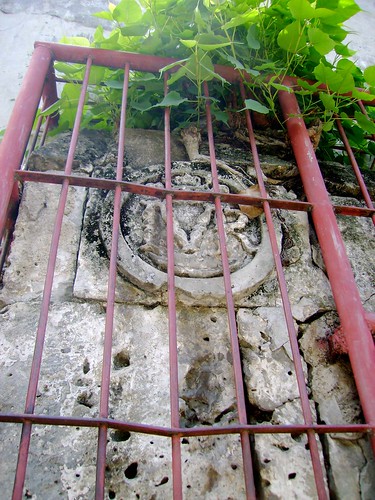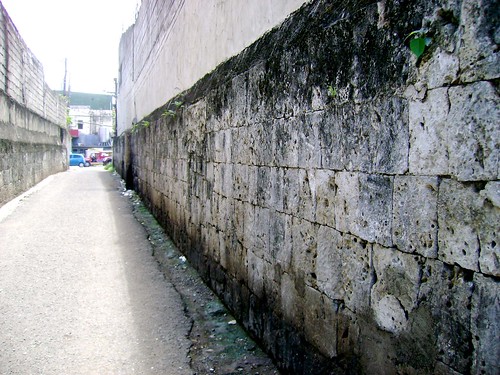
A beautiful Marian monogram
The Jesuit House in Parian is definitely a lost treasure, not too many people know it still exists! It’s now a warehouse own by a Filipino-Chinese family, a depot for the family’s hardware business.
There are some lucky few who were able to get inside, I did attempt to enter but was discouraged by what I’ve seen, a snobbish rude fellow manning its tall metal gate and rusting scraps of metal, wires and crude dripping on the floor – thick dust and industrial supplies are all over the place. I just took some photos then left.
The house still bravely stands, believe it or not, but one must wonder how long considering that this house has been around for more than two centuries without much care. I don’t blame the new owners for they have acquired this historical house legally. Being a lover of history, and knowing how important this place is, I feel bad but there’s truly not much we can do.
In fairness to the Chinese Filipino family that now owns place, they have been known to accommodate request from interested parties and the fact that they haven’t touch the old house says something about them, they’re obviously aware of its significance to history. Add to these are their effort to protect the relieves by enclosing them in iron grills, protecting them from vandals and keeping the old convento intact even if they can do away without it.
"]

The thick cut coral stone wall of the Convento
With its thick coral stone walls it is hidden and can only be seen upon entering an esquinita from Mabini St, formerly Calle Binacayan, I’m not exactly sure where the opening of these convent is or what it looks like from the inside, but the walls from the outside had the IHS symbols cut from coral stones which is almost unrecognizable.
I found this article on the net posted by an Atenean website:
Heritage Features: The whole compound is surrounded by a wall made of cut coral. The wall is divided by short piers on which are relieves bearing the monogram IHS, meaning Jesus. The original gate to the residence is along the side road named Binakayan. The gate’s lintel is decorated with monograms of Jesus, Mary and Joseph. These bas relieves in soft coral have unfortunately eroded because of wind and rain and also because vehicles have scarped the wall along the very narrow Binakayan road. To protect the monograms on the gate, the Sy family has installed a metal gate and a roof over the gate. To see the monograms on the lintel permission is needed as the steel gate is locked.
Entrance to the compound is through a new opening at Zulueta. Inside the compound are two structures. The structure closest to Zulueta bears traces of renovation. It is a bipartite building, the lower story of coral and the upper of wood. The stairway leading to the first house is of 20th-century vintage. The roof of the house is supported by stout unhewn tree trunks decorated with corbels.
This house is connected by a bridge to a second house. Like the convento of Santo Niño the second house is all of cut coral. Stout unhewn timbers support a heavy tile roof. The roof line curves outward in the same manner as Chinese style roofs. Iron grilles bar the windows of the second story. The house is no longer divided as it may have looked in the 18th century. Divisions into rooms are of 20th century vintage. The main door of the house is permanently locked and the decorative banister and newel post of the stairway is gone. Oral tradition has it that the Alvarez family brought the banister and newel post to a new house they were building in Bohol. Both banister and post were similar in design to those found in the convento of Santo Niño.
---
This heritage house unfortunately was passed on from the Jesuits to private families and at one point a club. This Jesuit residence was built in 1730, when these Friars were expelled in 1760’s the beautiful house was auctioned together with almost all the properties of the order.
I can imagine that this house must’ve been an admired structure, an imposing building not only in Parian but the whole of Cebu, there was even a tower similar to the bantayan sa hari that guards it from raiders, an indication that it was more than just a convento.
The Jesuits location greatly benefited their mission as they have mostly affluent parishioners who generously donate to their fund. These ‘rich’ contributions became a source of conflict between the missions. The house need not to contend anymore for anything than its preservation, this once mighty house could be seeing its end but the seeds of Catholicism has already spread, it has done it share, it’s a shame that we don’t even care to look after our heritage, our roots.



No comments:
Post a Comment